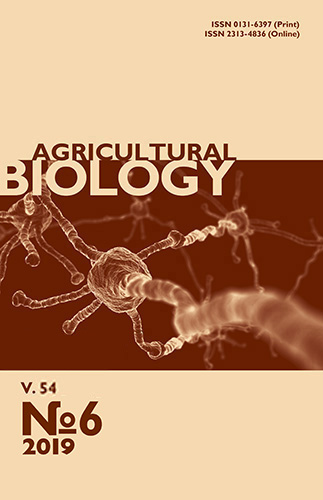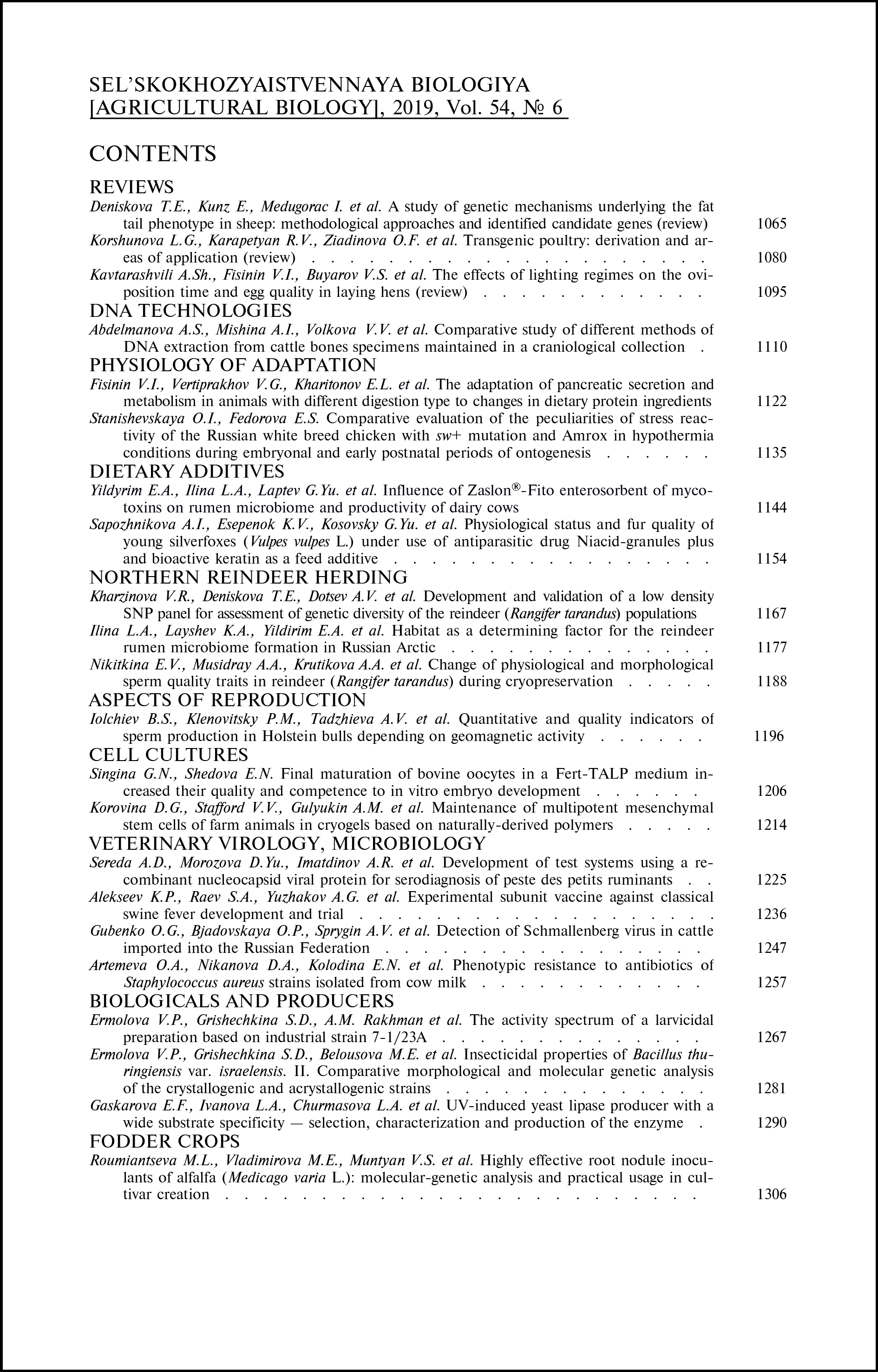doi: 10.15389/agrobiology.2019.6.1306eng
UDC: 636.2:631.52:631.461.52
Acknowledgements:
Supported financially by Ministry of Science and Higher Education of the Russian Federation (Agreement No. 14.607.21.0178, RFMEFI60717X0178)
HIGHLY EFFECTIVE ROOT NODULE INOCULANTS OF ALFALFA (Medicago varia L.): MOLECULAR-GENETIC ANALYSIS AND PRACTICAL USAGE IN CULTIVAR CREATION
M.L. Roumiantseva1, M.E. Vladimirova1, V.S. Muntyan1,
G.V. Stepanova2, A.S. Saksaganskaya1, A.P. Kozhemyakov1,
A.G. Orlova3, A. Becker4, B.V. Simarov1
1All-Russian Research Institute for Agricultural Microbiology, 3, sh. Podbel’skogo, St. Petersburg—Pushkin, 196608 Russia, e-mail mroumiantseva@yandex.ru (✉ corresponding author), mariiacherkasova@mail.ru, allasaksaganskaya@mail.ru, vucovar@yandex.ru, kojemyakov@rambler.ru, genet@yandex.ru;
2Williams Federal Research Center for Fodder Production and Agroecology,1, Nauchnii Gorodok, Lobnya, Moscow Province, 141055 Russia, e-mail gvstep@yandex.ru;
3Saint Petersburg State Agrarian University, 2, Peterburgskoe sh., St. Petersburg—Pushkin, 196601 Russia, e-mail yanevich-2@mail.ru;
4Philipps-University, Marburg, SYNMIKRO, Center for Synthetic Microbiology, 35043 Germany, Marburg, Hans-Meerwein Str. 6, e-mail anke.becker@synmikro.uni-marburg.de
ORCID:
Roumiantseva M.L. orcid.org/0000-0001-5582-6473
Kozhemyakov A.P. orcid.org/0000-0002-9657-2454
Vladimirova (Cherkasova) M.E. orcid.org/0000-0003-1873-9674
Orlova A.G. orcid.org/0000-0002-2211-5824
Muntyan V.S. orcid.org/0000-0002-1979-0853
Becker A. orcid.org/0000-0003-4561-9184
Stepanova G.V. orcid.org/0000-0001-9721-1207
Simarov B.V. orcid.org/0000-0002-6893-557X
Saksaganskaya A.S. orcid.org/0000-0002-8547-4904
Received October 5, 2019
In grass stands of perennial fodder legumes, alfalfa is a preferred leguminous plant for the creation of cultivated pastures and restoration of degraded soils. Medicago sativa L. nothosubsp. Varia (Martyn) Arcang is a high-yielding crop and resistant to adverse cultivation conditions, which is important for risky farming zones in Russia. Alfalfa productivity largely depends on the success of the formation of a plant-microbial symbiotic system with root nodule bacteria (rhizobia), which becomes able to fix atmospheric nitrogen. Modern symbiogenetics has shown that the effectiveness of symbiotic systems depends on the complementary interaction of the plant and microsymbiont genomes. Proceeding from this, the biological products that are used to treat legume seeds should also contain selected rhizobia strains with corresponding genotypic characteristics. In the present work, a comparative analysis of the yield of 73 variety-strain combinations, including Sinorhizobium meliloti represented by isolates from salt affected areas and by two strains (425a and 415b) of commercial importance, with alfalfa varieties obtained by classical and symbiotically depended plant breeding approaches was performed. The prospects of selecting highly effective strains those complementary to economically valuable varieties of alfalfa in model experiments have been shown. The strains A1 and A2 were found to be symbiotically more active with tested alfalfa varieties than strains of commercial importance. It has been evaluated that cultivar-strain combinations based on cultivars obtained by a symbiotically depended plant breeding approach are characterized by increased adaptability, and their potential to increase yield significantly exceeds 50 %. It was revealed that yields of variety-strain combinations formed by strain 425a are under the influence of uncontrolled factors according to two-factor analysis of variance. A high complementarity of strains A1 and A2 to the Agnia variety, and the functional significance of the genetic characteristics of strain 425a, led us to study their genomic characteristics. A comparative analysis of genomes done by using DNA biochips approach revealed significant differences between symbiotically highly effective strains. It was established that genes related to symbiotic activity and stress tolerance of rhizobia had a divergent structure mainly in strains recovered from salinized soils. The data of the first stages of the molecular genetic analysis of highly effective strains strongly indicate the need to continue research that will allow targeted selection of microsymbiont strains for modern varieties of alfalfa. Data produced through the research of a number of variety-strain combinations grown in various climatic conditions of the Russian Federation clearly demonstrate the need for the widespread introduction of a symbiotically depended plant breeding approach in order to create new economically valuable varieties of legumes needed to form a sustainable forage base for farmers.
Keywords: Medicago varia, Sinorhizobium meliloti, alfalfa varieties, plant breeding approaches, symbiotic genes and stress tolerance genes, DNA biochip SM6kOligo, genomic islands, symbiotically effective variety-strain combinations, sustainable forage base.
REFERENCES
- Ivanov A.I. Lyutserna [Alfalfa]. Moscow, 1980 (in Russ.).
- Dubovskii I.I. Agroenergeticheskaya otsenka kul'tur i osnovnye napravleniya sovershenstvovaniya polevogo kormoproizvodstva v stepnykh raionakh Tsentral'no-Chernozemnoi polosy. Avtoreferat kandidatskoi dissertatsii [Agro-energy crop assessment and the main directions for improving field feed production in the steppe regions of the Central Black Earth Strip. PhD Thesis]. Moscow, 2000 (in Russ.).
- Gosudarstvennyi reestr selektsionnykh dostizhenii, dopushchennykh k ispol'zovaniyu. Tom 1. Sorta rastenii (ofitsial'noe izdanie) [The state register of selection achievements allowed for use. Vol. 1. Varieties of plants (official publication)]. Moscow, 2019 (in Russ.).
- Shamsutdinov Z.Sh. Forage crops selection: progress and challenges. Sel’skokhozyaistvennaya Biologiya [Agricultural Biology], 2014, 6: 36-45 CrossRef
- Bzheumykhov V.S., Kobozev I.V., Tokbaev M.M. Izvestiya Timiryazevskoi sel'skokhozyaistvennoi akademii, 2007, 2: 28-37 (in Russ.).
- Provorov N.A., Simarov B.V. Sel’skokhozyaistvennaya Biologiya [Agricultural Biology], 1986, 12: 37-42.
- Fotev Yu.V., Sidorova K.K., Novikova T.I., Belousova V.P. Vavilovskii zhurnal genetiki i selektsii, 2016, 20(3) 348-354 CrossRef (in Russ.).
- Shkarupa M.V. Sbornik materialov X Vserossiiskoi konferentsii molodykh uchenykh i spetsialistov «Aktual'nye voprosy biologii, selektsii, tekhnologii vozdelyvaniya i pererabotki maslichnykh i drugikh tekhnicheskikh kul'tur» [Proc. X All-Russian Conference of Young Scientists and Specialists «Actual issues of biology, breeding, technology for the cultivation and processing of oilseeds and other industrial crops»]. Krasnodar, 2019: 231-235 (in Russ.).
- Ddelić D., Stajković-Srbinović O., Radović J., Kuzmanović D., Rasulić N., Simić A., Knežević-Vukčević E. Differences in symbiotic N2 fixation of alfalfa, Medicago sativa L. cultivars and Sinorhizobium spp. strains in field conditions. Romanian Biotechnological Letters, 2013, 18(6): 8743-8750.
- Shamseldin A., Youseif S.H., Abd El-Megeed F.H., Abdelkhalek A., Sadowsky M.J., Saleh S.A. Selection and use of effective, competitive, clover-nodulating rhizobium strains for use as commercial inoculants in alkaline and salt affected egyptian soils. Asian Academic Research Journal of Multidisciplinary, 2016, 3(7): 2319-2801.
- Yadav J., Verma J.P., Rajak V.K., Tiwari K.N. Selection of effective indigenous rhizobia strain for seed inoculation on chickpea (Cicer aritenium L.) production. Bacteriology Journal, 2011, 1(1): 24-30 CrossRef
- Gasanov G.N., Usmanov R.Z., Musaev M.R., Abasov M.M. Sel’skokhozyaistvennaya Biologiya [Agricultural Biology], 2007, 1: 79-85.
- Rumyantseva M.L., Stepanova G.V., Kurchak O.N., Onishchuk O.P., Muntyan V.S., Dzyubenko E.A., Dzyubenko N.I., Simarov B.V. Selection of salt tolerant alfalfa (Medicago L.) plants from different varieties and their morfo biological and symbiotic properties analysis. Agricultural Biology [Sel’skokhozyaistvennaya Biologiya], 2015, 50(5): 673-684 CrossRef
- Aranjuelo I., Arrese-Igor C., Molero G. Nodule performance within a changing environmental context. Journal of Plant Physiology, 2014, 171(12): 1076-1090 CrossRef
- Mahajan S., Tuteja N. Cold, salinity and drought stresses: an overview. Archives of Biochemistry and Biophysics, 2005, 444(2): 139-58 CrossRef
- O’Hara G., Yates R., Howieson J. Selection of strains of root nodule bacteria to improve inoculants performance and increase legume productivity in stressful environments. In: Inoculants and nitrogen fixation of legumes in Vietnam /D. Herridge (ed.). ACIAR Proceedings, 2002: 75-80.
- Sańko-Sawczenko I., Łotocka B., Mielecki J., Rekosz-Burlaga H., Czarnocka W. Transcriptomic changes in Medicago truncatula and Lotus japonicus root nodules during drought stress. International Journal of Molecular Sciences, 2019, 20(5): 1204 CrossRef
- Salim A., Cheloufi H., Attab S., Bouras N. Improvement of alfalfa growth under water stress by inoculation with Sinorhizobium meliloti strains from the Algerian Sahara. International Journal of Sciences and Research. 2019, 75(7/1): 35-40 CrossRef
- Vriezen J.A., de Bruijn F.J., Nüsslein K. Responses of rhizobia to desiccation in relation to osmotic stress, oxygen, and temperature. Applied and Environmental Microbiology, 2007, 73(11): 3451-3459 CrossRef
- Xu J., Li X.L., Luo L. Effects of engineered Sinorhizobium meliloti on cytokinin synthesis and tolerance of alfalfa to extreme drought stress. Biotechnology, 2012, 78(22): 8056-8061 CrossRef
- Lazarev N.N. Vestnik OrelGAU, 2006, (2-3): 55-56 (in Russ.).
- Bourion V., Heulin-Gotty K., Aubert V., Tisseyre P., Chabert-Martinello M., Pervent M., Delaitre C., Vile D., Siol M., Duc G., Brunel B., Burstin J., Lepetit M. Co-inoculation of a Pea Core-Collection with diverse rhizobial strains shows competitiveness for nodulation and efficiency of nitrogen fixation are distinct traits in the interaction. Frontiers in Plant Science, 2018, 8: 2249 CrossRef
- Tikhonovich I.A., Andronov E.E., Borisov A.Yu., Dolgikh E.A., Zhernakov A.I., Zhukov V.A., Provorov N.A., Rumyantseva M.L., Simarov B.V. Genetika, 2015, 51(9): 831-846 CrossRef (in Russ.).
- Gubry-Rangin C., Garcia M., Bena G. Partner choice in Medicago truncatula-Sinorhizobium symbiosis. Proceedings. Biological sciences, 2010, 277(1690): 1947-1951 CrossRef
- Wang D., Yang S., Tang F., Zhu H. Symbiosis specificity in the legume-rhizobial mutualism. Cellular Microbiology, 2012, 14(3): 334-342 CrossRef
- Khapchaeva S.A., Didovich S.V., Topunov A.F., Mulyukin A.L., Zotov V.S. Ekologicheskaya genetika, 2018, 16(4): 51-60 CrossRef (in Russ.).
- Argaw A. Symbiotic effectiveness of inoculation with Bradyrhizobium isolates on soybean [Glycine max (L.) Merrill] genotypes with different maturities. Springerplus, 2014, 3: 753 CrossRef
- Vorobeikov G.A., Bredikhin V.N. Mikroorganizmy v agrobiotekhnologiyakh i zashchite prirodnoi sredy. SPb, 2018.
- Kozhemyakov A.P., Laktionov Yu.V., Popova T.A., Orlova A.G., Kokorina A.L., Vaishlya O.B., Agafonov E.V., Guzhvin S.A., Churakov A.A., YAkovleva M.T. The scientific basis for the creation of new forms of microbial biochemicals. Agricultural Biology [Sel’skokhozyaistvennaya Biologiya], 2015, 50(3): 369-376 CrossRef
- Arafa M.M., El-Batanony N.H., Nofal A.M. Inoculation effect of rhizobial strains on growth, yield and chemical composition of some legume crops in new reclaimed soil. Middle East Journal of Agriculture Research, 2018, 7(2): 352-363.
- Buntic A.V., Stajkovic-Srbinovic O.S., Knezevic M.M., Kuzmanovic D.Z., Rasulic N.V., Delic D.I. Development of liquid rhizobial inoculants and pre-inoculation of alfalfa seeds. Archives of Biological Sciences, 2019, 71(2): 379-387 CrossRef
- Solomon T., Pant L.M., Angaw T. Effects of Inoculation by Bradyrhizobium japonicum strains on nodulation, nitrogen fixation, and yield of soybean (Glycine max L. Merill) varieties on Nitisols of Bako, Western Ethiopia. ISRN Agronomy, 2012, Article ID 261475 CrossRef
- Atlasova L.G. Izvestiya Samarskogo nauchnogo tsentra Rossiiskoi akademii nauk, 2015, 17(5): 77-80 (in Russ.).
- Tsotsieva V.P., Basieva L.Zh., Kozyrev A.Kh. Izvestiya Gorskogo gosudarstvennogo agrarnogo universiteta, 2015, 52(4): 57-62 (in Russ.).
- Deaker R., Roughley R.J., Kennedy I.R. Legume seed inoculation technology — a review. Soil Biology and Biochemistry, 2004, 36(8): 1275-1288 CrossRef
- Drobysheva L.V., Zyatchina G.P. Adaptivnoe kormoproizvodstvo, 2016, 3: 94-108 (in Russ.).
- Stepanova G.V., Zolotarev V.N. Adaptivnoe kormoproizvodstvo, 2015, 1: 28-38 (in Russ.).
- Ibragimova M.V., Rumyantseva M.L., Onishchuk O.P., Belova V.S., Kurchak O.N., Andronov E.E., Dzyubenko N.I., Simarov B.V. Mikrobiologiya, 2006, 75(1): 94-100 (in Russ.).
- Beringer J.E. R factor transfer in Rhizobium leguminosarum. Journal of General Microbiology, 1974, 84: 188-198 CrossRef
- Rumyantseva M.L., Simarov B.V., Onishchuk O.P., Andronov E.E., Chizhevskaya E.P., Belova V.S., Kurchak O.N., Muntyan A.N., Rumyantseva T.B., Zatovskaya T.V. Biologicheskoe raznoobrazie kluben'kovykh bakterii v ekosistemakh i agrotsenozakh. Teoreticheskie osnovy i metody /Pod redaktsiei M.L. Rumyantsevoi, B.V. Simarova [The biological diversity of nodule bacteria in ecosystems and agrocenoses. Theoretical foundations and methods. M.L. Rumyantseva, B.V. Simarov (eds.)]. St. Petersburg, 2011 (in Russ.).
- Cherkasova M.E., Muntyan V.S., Saksaganskaya A.S., Simarov B.V., Rumyantseva M.L. Ekologicheskaya genetika, 2019, 17(3): 23-38 CrossRef (in Russ.).
- Giuntini E., Mengoni A., De Filippo C., Cavalieri D., Aubin-Horth N., Landry C.R., Becker A., Bazzicalupo M. Large-scale genetic variation of the symbiosis-requiered megaplasmid pSymA revealed by comparative genomic analysis of Sinorhizobium meliloti natural strains. BMC Genomics, 2005, 6: Article number 158 CrossRef
- Kim C.C., Joyce E.A., Chan K., Falkow S. Improved analytical methods for microarray-based genome-composition analysis. Genome Biology, 2002, 3(11): RESEARCH0065 CrossRef
- Raionirovannye i perspektivnye sorta kormovykh kul'tur selektsii VNII kormov im. V.R. Vil'yamsa. Katalog [Zoned and promising varieties of feed crops breeding VNII feed them. V.R. Williams. Catalog]. Moscow, 2007 (in Russ._.
- Pustyl'nik E.I. Statisticheskie metody analiza i obrabotki nablyudenii [Statistical methods for the analysis and processing of observations]. Moscow, 1968 (in Russ._.
- Lakin G.F. Biometriya [Biometrics]. Moscow, 1990 (in Russ.).
- Gmurman V.E. Teoriya veroyatnostei i matematicheskaya statistika [Theory of Probability and Mathematical Statistics].Moscow, 2004 (in Russ.).
- Hammer O., Harper D.A.T., Ryan P.D. PAST: paleontological statistics software package for education and data analysis. Palaeontologia Electronica, 2001, 4(1):1-9.
- Rumyantseva M.L., Muntyan V.S., Cherkasova M.E., Andronov E.E., Saksaganskaya A.S., Dzyubenko E.A., Dzyubenko N.I., Simarov B.V. A comparative analysis of genomic characters of reference Sinorhizobium meliloti strains, the alfalfa symbionts (review). Agricultural Biology [Sel’skokhozyaistvennaya Biologiya], 2017, 52(5): 928-939 CrossRef












